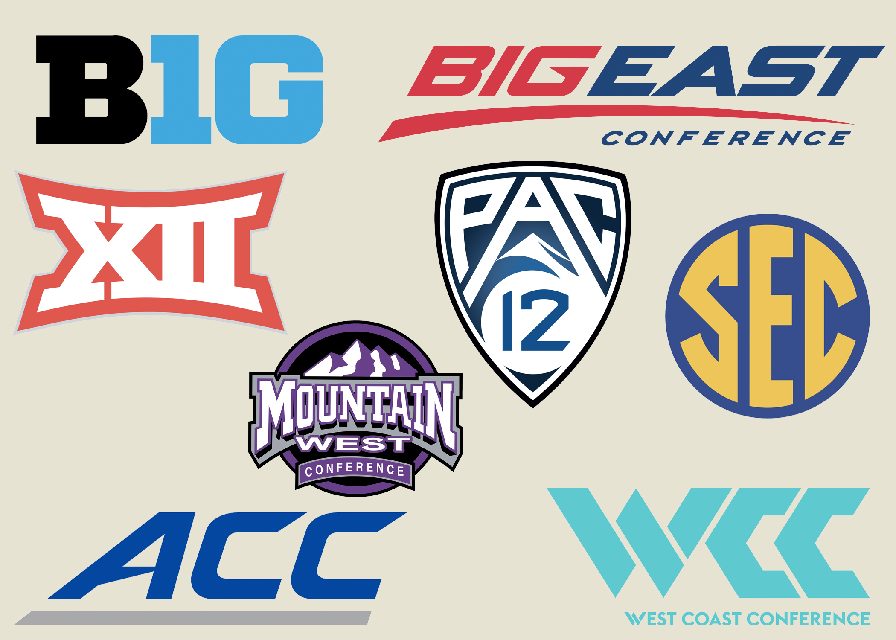The most important conferences in the NCAA to know
Conferences
What you need to know about the organization of teams
College basketball teams are broken into conferences, which are groups of teams — mostly located near each other — who frequently compete with one another during the regular season. Teams are grouped based on the size of the school and the history of the teams’ basketball programs, and each team ends the year with an overall record and conference record. The conference record is usually more indicative of success than the overall record, but not all conferences are equally challenging.
Each conference hosts an end-of-season tournament, and the winner of each conference receives an automatic selection to the Big Dance, known as a bid. This is especially important for schools known as “mid-majors,” who are competing with other smaller schools outside of the top conferences. Winning a conference championship allows teams who would’ve otherwise missed out to have a chance to compete in the National Championship.
There are 32 conferences but the most important ones to know are the following:
B1G (pronounced Big 10):
The Big 10. Although the name suggests this conference would feature ten teams, there are actually 14 teams in the Big 10. This conference is one of the most well-rounded, and the national tournament will feature nine of its teams (Michigan, Michigan State, Rutgers, Indiana, Illinois, Purdue, Iowa, Iowa State, and Ohio State). Expect the B1G teams to perform well in this tournament, looking to make deep runs.
Big East:
The Big East is one of college basketball’s biggest powerhouses, and they rarely disappoint. Featuring some of the biggest names in college basketball over the past decade, this conference has won the tournament four times in the last 10 years. This year’s tournament will feature six teams out of the Big East’s 11 total teams (Villanova, Creighton, UConn, Providence, Seton Hall, and Marquette).
Big 12:
Another basketball powerhouse, the Big 12 is also an ironic misnomer. Including 10 total teams in the conference, the Big 12 will be represented this year by five teams, including the reigning champions: the Baylor Bears. The Big 12 is led by Kansas, but also sent three other squads (TCU, Texas, and Texas Tech) to this year’s tournament.
SEC:
The Southeastern Conference (SEC) is more known for its football teams, but they do have a few strong basketball programs. Six teams in the field is an impressive number for the SEC, which is usually a very top-heavy conference. Florida and Kentucky have each won National Championships since 2000, with Florida winning back to back in ‘06 and ‘07. The following teams will represent the SEC in this year’s tournament (Kentucky, Florida, Auburn, Tennessee, Arkansas, and LSU).
ACC:
The Atlantic Coast Conference is almost always the strongest in college basketball. These schools are the pinnacle of college basketball success, including the decades-old rivalry of UNC and Duke. Both of these teams will be featured in the tournament, but only two others, Notre Dame and Virginia Tech, will be representing the ACC this year. This is the lowest number of teams from the ACC in eight years.
Mountain West:
The Mountain West is a bit of an unusual conference, not usually a top performer when it comes to basketball. The conference will be represented by four teams this year (San Diego State, Boise State, Colorado State, and Wyoming). This is considered a weaker conference, so local success should be taken with a grain of salt.
WCC:
One of the most controversial conferences in all of collegiate basketball is the West Coast Conference, which features #1 ranked Gonzaga. This is the second consecutive year that Gonzaga is coming into the tournament as a one seed, and the Bulldogs finished second last year, losing to Baylor in the championship. Now, here’s where the controversy lies: Gonzaga has only played 4 ranked teams this year (excluding in-conference Saint Mary’s). Their very weak conference has allowed them a very easy conference schedule each year, only losing once across the past two seasons. Many have called for Gonzaga to join a more competitive conference, but for now, they remain isolated in the WCC. In addition to Gonzaga, there are only two other conference teams featured in the tournament (Saint Mary’s and San Francisco).
PAC 12:
After posting an impressive 2021 showing in the tournament, the Pacific 12 will look to continue their successes. Last year was supposed to be a down year for them, posting very unimpressive teams during regular season play. But much to everyone’s surprise, the Pac-12 sent three teams to the Elite Eight, including 12-seed UCLA who advanced all the way to the Final Four. The Pac-12 isn’t just filled with underdog teams though. Arizona is the top seed in the South region this year, and with three other teams (UCLA, USC, Arizona) in this year’s tournament to represent the conference, who knows what could happen? After all, this is March.
Now that conferences have been reviewed, here are some phrases you can use to sound like you know what you’re talking about.
“Gonzaga really needs to play some tougher teams. Their strength of schedule is a joke!”
“The B1G looks really good this year!”
“I can’t believe the ACC is so weak this year!”
“I can really see the Big East doing well this year. They’re always good”
